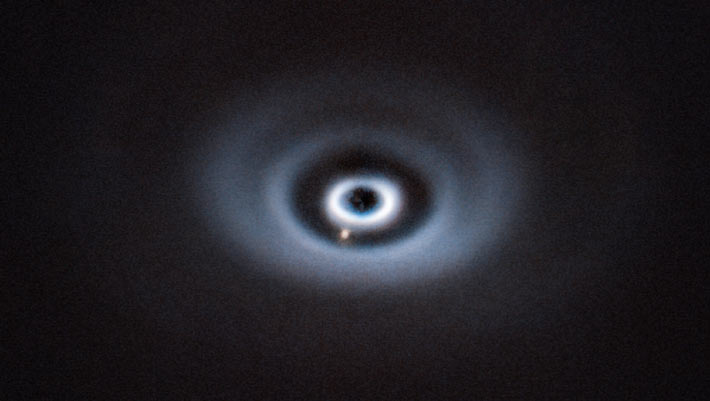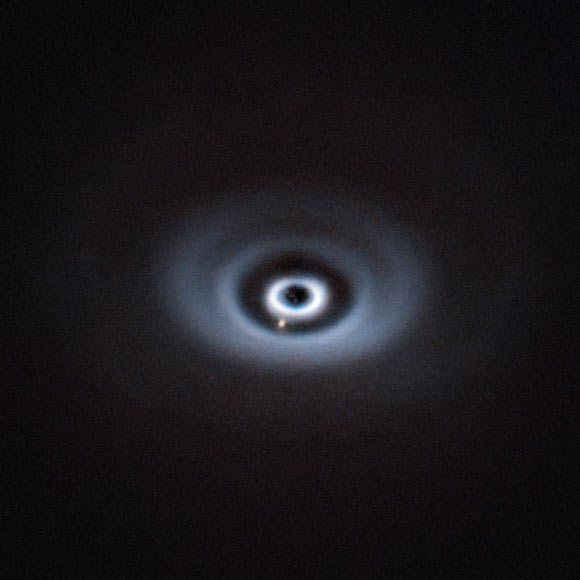Using the SPHERE instrument on ESO’s Very Large Telescope (VLT), astronomers have directly imaged a 4.9-Jupiter-mass protoplanet in a cleared gap of a multi-ringed protoplanetary disk around WISPIT 2 (TYC 5709-354-1), a 5-million-year-old solar analog located 133 parsecs (434 light-years) on the constellation of Aquila.
This image, taken with ESO’s Very Large Telescope, is the first clear detection of a protoplanet in a disk with multiple rings. Image credit: ESO / van Capelleveen et al.
Protoplanetary disks surround young stars and appear as disk-shaped structures of gas and dust, often with rings.
They are the birthplace of planets, and the rings are thought to indicate the presence of (hungry) planets in the disk.
Initially, little particles in the spinning disk begin to accumulate and grow as gravity takes over, stealing more material from the native disk until they evolve into embryo planets.
“Discovering this planet, WISPIT 2b, was an amazing experience — we were incredibly lucky,” said Dr. Richelle van Capelleveen, an astronomer at Leiden Observatory.
“WISPIT 2, a young version of our Sun, is located in a little-studied group of young stars, and we did not expect to find such a spectacular system.”
“This system will likely be a benchmark for years to come.”
“We used these really short snapshot observations of many young stars — only a few minutes per object — to determine if we could see a little dot of light next to them that is caused by a planet,” said Dr. Christian Ginski, a researcher at the University of Galway.
“However, in the case of this star, we instead detected a completely unexpected and exceptionally beautiful multi-ringed dust disk.”
“When we saw this multi-ringed disk for the first time, we knew we had to try and see if we could detect a planet within it, so we quickly asked for follow-up observations.”
The astronomers captured a spectacular clear image of WISPIT 2b embedded in a disk gap and confirmed that the planet is orbiting its host star.
“WISPIT 2b is the first unambiguous planet detection in a multi-ringed disk, making it the ideal laboratory to study planet-disk interaction and subsequent evolution,” they said.
WISPIT 2b was captured in near infrared light as it is still glowing and hot after its initial formation phase.
The planet was also detected in visible light using the MagAO-X AO system on the 6.5-m Magellan telescope and the LMIRcam instrument on the Large Binocular Telescope Interferometer (LBTI).
This detection at a specific wavelength or color of light indicates that the planet is still actively accreting gas as it is forming its atmosphere.
“WISPIT 2b, with its position within its birth disk, is a beautiful example of a planet that can be used to explore current planet formation models,” said Chloe Lawlor, a Ph.D. student at the University of Galway.
According to the team, the disk around WISPIT 2b has a radius of 380 AU (astronomical units) — about 380 times the distance between Earth and the Sun.
“WISPIT 2b is a remarkable discovery,” said Jake Byrne, a M.Sc. student at the University of Galway.
The results appear in two papers in the Astrophysical Journal Letter.
_____
Richelle F. van Capelleveen et al. 2025. WIde Separation Planets In Time (WISPIT): A Gap-clearing Planet in a Multi-ringed Disk around the Young Solar-type Star WISPIT 2. ApJL 990, L8; doi: 10.3847/2041-8213/adf721
Laird M. Close et al. 2025. Wide Separation Planets in Time (WISPIT): Discovery of a Gap Hα Protoplanet WISPIT 2b with MagAO-X. ApJL 990, L9; doi: 10.3847/2041-8213/adf7a5


